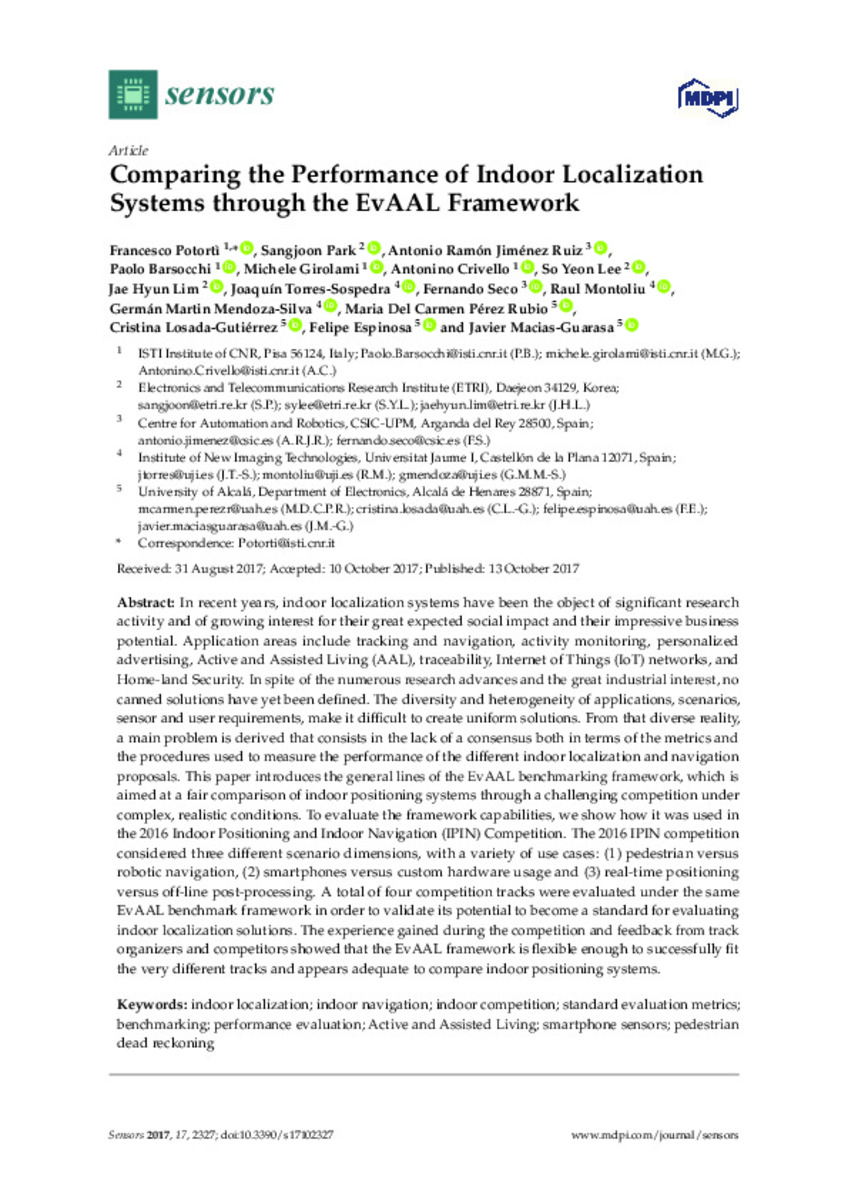Mostrar el registro sencillo del ítem
Comparing the Performance of Indoor Localization Systems through the EvAAL Framework
| dc.contributor.author | Potortì, Francesco | |
| dc.contributor.author | Park, Sangjoon | |
| dc.contributor.author | Jimenez Ruiz, Antonio Ramon | |
| dc.contributor.author | Barsocchi, Paolo | |
| dc.contributor.author | GIROLAMI, MICHELE | |
| dc.contributor.author | Crivello, Antonino | |
| dc.contributor.author | Lee, So-Yeon | |
| dc.contributor.author | Lim, Jae Hyun | |
| dc.contributor.author | Torres-Sospedra, Joaquín | |
| dc.contributor.author | Seco, Fernando | |
| dc.contributor.author | Montoliu Colás, Raul | |
| dc.contributor.author | Mendoza-Silva, Germán Martín | |
| dc.contributor.author | María del Carmen, Pérez Rubio | |
| dc.contributor.author | Cristina, Losada Gutiérrez | |
| dc.contributor.author | Espinosa, Felipe | |
| dc.contributor.author | Macias-Guarasa, Javier | |
| dc.date.accessioned | 2017-12-21T20:09:41Z | |
| dc.date.available | 2017-12-21T20:09:41Z | |
| dc.date.issued | 2017 | |
| dc.identifier.citation | Potortì, F.; Park, S.; Jiménez Ruiz, A.R.; Barsocchi, P.; Girolami, M.; Crivello, A.; Lee, S.Y.; Lim, J.H.; Torres-Sospedra, J.; Seco, F.; Montoliu, R.; Mendoza-Silva, G.M.; Pérez Rubio, M.D.C.; Losada-Gutiérrez, C.; Espinosa, F.; Macias-Guarasa, J. Comparing the Performance of Indoor Localization Systems through the EvAAL Framework. Sensors 2017, 17, 2327. | ca_CA |
| dc.identifier.issn | 1424-8220 | |
| dc.identifier.uri | http://hdl.handle.net/10234/171333 | |
| dc.description.abstract | In recent years, indoor localization systems have been the object of significant research activity and of growing interest for their great expected social impact and their impressive business potential. Application areas include tracking and navigation, activity monitoring, personalized advertising, Active and Assisted Living (AAL), traceability, Internet of Things (IoT) networks, and Home-land Security. In spite of the numerous research advances and the great industrial interest, no canned solutions have yet been defined. The diversity and heterogeneity of applications, scenarios, sensor and user requirements, make it difficult to create uniform solutions. From that diverse reality, a main problem is derived that consists in the lack of a consensus both in terms of the metrics and the procedures used to measure the performance of the different indoor localization and navigation proposals. This paper introduces the general lines of the EvAAL benchmarking framework, which is aimed at a fair comparison of indoor positioning systems through a challenging competition under complex, realistic conditions. To evaluate the framework capabilities, we show how it was used in the 2016 Indoor Positioning and Indoor Navigation (IPIN) Competition. The 2016 IPIN competition considered three different scenario dimensions, with a variety of use cases: (1) pedestrian versus robotic navigation, (2) smartphones versus custom hardware usage and (3) real-time positioning versus off-line post-processing. A total of four competition tracks were evaluated under the same EvAAL benchmark framework in order to validate its potential to become a standard for evaluating indoor localization solutions. The experience gained during the competition and feedback from track organizers and competitors showed that the EvAAL framework is flexible enough to successfully fit the very different tracks and appears adequate to compare indoor positioning systems. | ca_CA |
| dc.format.extent | 28 p. | ca_CA |
| dc.format.mimetype | application/pdf | ca_CA |
| dc.language.iso | eng | ca_CA |
| dc.publisher | MDPI | ca_CA |
| dc.relation.isPartOf | Sensors, 2017, vol. 17, núm. 10, p. 2327. | ca_CA |
| dc.rights | © 2017 by the authors. Licensee MDPI, Basel, Switzerland. This article is an open access article distributed under the terms and conditions of the Creative Commons Attribution (CC BY) license (http://creativecommons.org/licenses/by/4.0/). | ca_CA |
| dc.rights | Atribución 4.0 Internacional | * |
| dc.rights.uri | http://creativecommons.org/licenses/by-sa/4.0/ | * |
| dc.subject | indoor localization | ca_CA |
| dc.subject | indoor navigation | ca_CA |
| dc.subject | indoor competition | ca_CA |
| dc.subject | standard evaluation metrics | ca_CA |
| dc.subject | benchmarking | ca_CA |
| dc.subject | performance evaluation | ca_CA |
| dc.subject | Active and Assisted Living | ca_CA |
| dc.subject | smartphone sensors | ca_CA |
| dc.subject | pedestrian dead deckoning | ca_CA |
| dc.title | Comparing the Performance of Indoor Localization Systems through the EvAAL Framework | ca_CA |
| dc.type | info:eu-repo/semantics/article | ca_CA |
| dc.identifier.doi | http://dx.doi.org/10.3390/s17102327 | |
| dc.relation.projectID | This work was supported by the ICT R&D program of MSIP/IITP, South Korea (2017-0-00543, Development of Precise Positioning Technology for the Enhancement of Pedestrian’s Position/Spatial Cognition and Sports Competition Analysis). Parts of this work were funded by the Spanish Government through the projects TIN2013-47630-C2-1-R, TIN2015-70202-P, TIN2016-75982-C2-1-R, TEC2015-64835-C3-2-R, DPI2013-47347-C2-1-R and TARSIUS TIN2015-71564-C4-2-R, the network REPNIN TEC2015-71426-REDT, and the José Castillejo mobility programme CAS16/00072. | ca_CA |
| dc.rights.accessRights | info:eu-repo/semantics/openAccess | ca_CA |
| dc.relation.publisherVersion | http://www.mdpi.com/1424-8220/17/10/2327 | ca_CA |
| dc.type.version | info:eu-repo/semantics/publishedVersion | ca_CA |
Ficheros en el ítem
Este ítem aparece en la(s) siguiente(s) colección(ones)
-
INIT_Articles [747]
-
ICC_Articles [417]
-
LSI_Articles [362]
Articles de publicacions periòdiques escrits per professors del Departament de Llenguatges i Sistemes Informàtics
Excepto si se señala otra cosa, la licencia del ítem se describe como: © 2017 by the authors. Licensee MDPI, Basel, Switzerland. This article is an open access
article distributed under the terms and conditions of the Creative Commons Attribution
(CC BY) license (http://creativecommons.org/licenses/by/4.0/).








